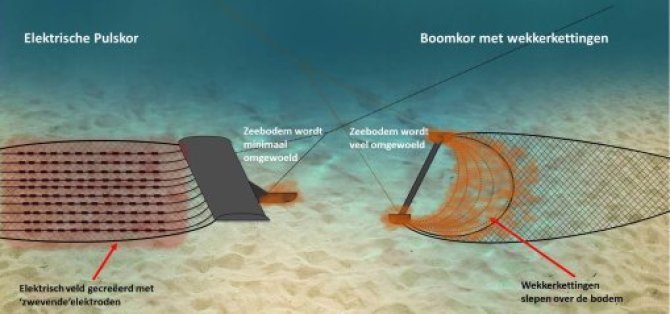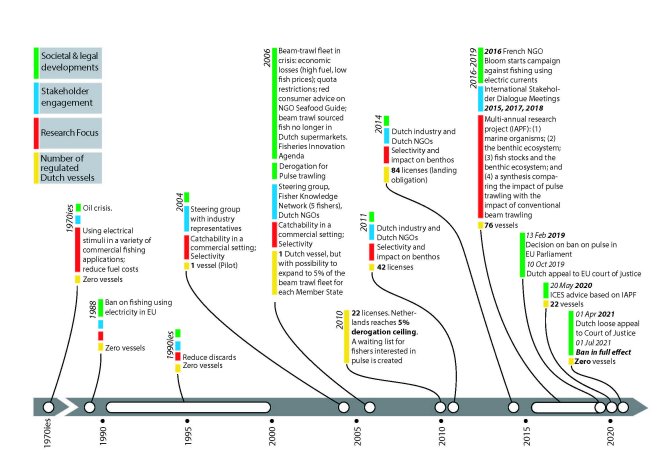
Dossier
Pulsvisserij
Wetenschappers en vissers zochten naar duurzamere manieren om platvis en garnalen te vangen en experimenteerden daarbij met pulsvissen. Bij die methode zijn de wekkerkettingen vervangen door elektroden die stroomstootjes afgeven: de pulskor. Wageningen University & Research onderzocht de voor- en nadelen van de pulskor voor mariene ecosystemen en de economie. Er is door het Europees Parlement in 2019 gestemd voor een verbod op pulsvisserij, ondanks dat wetenschappelijk onderzoek heeft uitgewezen dat het een duurzaam alternatief is voor de visserij op tong. Het algehele pulsverbod is per 1 juli 2021 van kracht.
Wat is pulsvisserij?
De Nederlandse visserijsector is sterk afhankelijk van tong die met de boomkor wordt gevangen. Boomkorren zijn uitgerust met wekkerkettingen die voor het net over de zeebodem worden gesleept, om platvis mechanisch van de zeebodem in het net te jagen. Deze kettingen veroorzaken een hoog brandstofverbruik, ongewenste bijvangst en verstoring van bentische ecosystemen. Gezien deze effecten is bodemsleepnetvisserij een zwaar bediscussieerd en controversieel type visserij. Een alternatief hiervoor was pulsvisserij. Deze techniek vervangt de zware kettingen van de traditionele boomkor door elektroden die elektrische pulsen afgeven die de doelsoorten immobiliseren (verkrampen) en ze beschikbaar te maken voor de vangst.

Waarom is onderzoek naar pulsvisserij belangrijk?
Pulsvissen is een techniek die sinds het begin van de jaren 1970 door Wageningen Marine Research en haar voorgangers op incidentele basis en op zeer kleine schaal is bestudeerd, gericht op selectiviteit. Hoge olieprijzen zorgden na 2000 voor hernieuwde belangstelling van industrie en ministeries, en in 2006 vroeg de EU aan de Internationale Raad voor het Onderzoek van de Zee (ICES) voor het eerst om advies over deze methode.
Meer verzoeken zouden volgen. Deze situatie gaf de aanzet tot een onderzoeksprogramma onder leiding van Wageningen Marine Research. Het onderzoeksprogramma vond aanvankelijk plaats op één commercieel schip en breidde zich later uit met veel meer schepen, omdat de noodzaak om alternatieven voor de boomkorvisserij te vinden toenam en de pulskor zich ontwikkelde van een nieuwe techniek die geplaagd werd door technische problemen en defecten, tot een betrouwbaar vistuig dat geschikt is voor de echte visserij.

Internationale component
De Nederlandse overheid investeerde in bijeenkomsten met belanghebbenden en maatschappelijke discussies om de introductie van deze nieuwe techniek in Nederland te vergemakkelijken.
De internationale component kwam echter jaren te laat op gang, en het onderwerp bleek veel controversiëler dan de regering had voorzien. Het Europese definitieve verbod op pulsvisserij was vooral gebaseerd op basis van politieke en sociaaleconomische overwegingen, ondanks beschikbare adviezen en onderzoeksresultaten van ICES. Op dat moment, liep het Wageningen Marine Research-onderzoeksprogramma nog. Op basis daarvan bracht ICES in mei 2020 advies uit waarin werd geconcludeerd dat de pulsvisserij op tong in de Noordzee beter scoort op relevante duurzaamheidsaspecten en -doelen dan het vissen met traditionele boomkor.
Wageningen Marine Research heeft veel bijgedragen aan kennisontwikkeling over de effecten van pulsvisserij, met als resultaat een ICES-advies met internationale wetenschappelijke overeenstemming - voor een groot deel gebaseerd op onderzoek van Wageningen Marine Research, Wageningen Economic Research, NIOZ en ILVO - dat concludeerde dat pulsvisserij zowel ecologisch als economisch beter is dan boomkorvisserij. Onze onderzoeksresultaten resulteerden ook in een sterke voorkeur voor pulsvisserij door de Nederlandse boomkorvisserij en LNV. Nederlandse NGO's die die gematigd positief tegenover deze techniek stonden, erkenden de voordelen van de nieuwe techniek. De politieke arena van de EU bleek echter heel anders te zijn en stond deze techniek niet toe, ondanks een (late) internationale discussie over dit onderwerp, georganiseerd door LNV.
Bekijk de animaties over het effect van pulsvisserij
- Helaas, uw cookie-instellingen zijn zodanig dat de video niet getoond kan worden - pas uw permissie voor cookies aan